Extending a Branch
In 1978, Xerox's Palo Alto Research Center was doing research (duh) on how to organize things onscreen in a brand-new way,
employing a system called a graphical user interface, or GUI, controlled by mouse. Xerox created a machine known as the Xerox
Alto, the first computer in the industry to run on this type of interface. The next year, Apple co-founder Steve Jobs decided to
try and modernize the Apple II. He started by visiting Xerox PARC to get a couple demonstrations of the Alto to show his team.
Jobs was amazed by the effectiveness of the GUI paired with the mouse, and Apple got to work on a GUI-based Apple II.
Out on a Twig
The new computer was called the Apple Lisa, which Steve Jobs named after his lone daughter. The name was also an acronym for Local
Integrated Software Architecture. Costing over $50 million to manufacture, the Apple Lisa was developed by well over 90 people and
as such, it took only six months to finish the interface. That left all the rest of the project to be developed simultaneously.
The first model, dubbed the Lisa 1, shipped with two 5 ¼" "Twiggy" floppy drives in January 1983. These drives used Apple's
proprietary FileWare diskettes, which were designed in 1978 with the Apple II, III, and Lisa in mind. These FileWare disks had a
cutout for the head on both sides of the center hole due to the read/write head arrangement in the Twiggy drives. Only the Lisa
was released with a drive built for the FileWare diskettes.

Pruned
Just after the Lisa with Twiggy drives started shipping, it was found the diskettes were unreliable, so it was redesigned one 3 ½"
drive and released in early 1984.

Timber!
The Lisa machines were very unsuccessful because of the insidiously high price, and the more feature-rich and affordable Macintosh
computer coming out. As the new GUI-based machine was cutting into potential and actual sales of the Lisa (what little of it there
was), the Apple Lisa was discontinued in 1986, with a total of 10,000 units sold.


